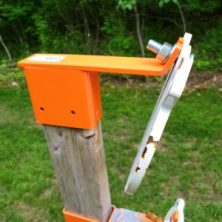For anyone who has shot at steel targets, you know that there’s something quite satisfying about that CLANG or PING sound and the instant feedback you get when you make contact. It can actually be quite addictive and can also be a beneficial addition to your practice routine.
Shooting steel targets is a good complement to the regular paper or cardboard variety in that they provide more options and flexibility for your skill development. While paper is a helpful tool in determining accuracy and how your shots may string, steel allows for differing set-ups and shot challenges that can absolutely improve your abilities. With a variety of sizes, shapes and movement options available, steel targets also generate more in the way of fun when shooting, and this can be a good way to re-energize yourself or get a beginner more enthusiastically interested in the sport.
Benefits
Aside from the items noted above, shooting steel also:
Provides an immediate, audible indication that you’ve made contact. No more peering through your scope or having to go down range to check results. Be aware though, that you don’t want to let real accuracy suffer and fall into a ‘that’ll do’ attitude with your shooting.
Allows for more shots per session since you can avoid the time spent having to regularly change targets.
Can provide more options for your training environments with differing tactical set-ups.
Creates opportunities for further skill development (timing & leads) with target movement and rotation.
Is convenient for portability, set-up and target changes. Easy spray paint touch ups also help.
Eliminates the need to break down your targets every time, as they can be left out in the elements for the most part.
Enhances training through better muscle memory development, as your body/senses will associate your movement and positioning with the immediate response of hitting the target.
Target Details
Not all steel is created equal. Good quality targets are made from hardened AR500 and AR550 hardened steel with specific thicknesses that will destroy or safely deflect bullets on impact. The Brinell Hardness Number (BHN) of at least 500 ensures that the impact resistance will maintain the structural and surface integrity of the target while allowing projectiles to follow normal rebound patterns.
There are a wide variety of target types available depending on your requirements. Whether you are shooting competitively, for tactical practice or  just for fun, you’d be hard pressed not to find exactly what you need. This is a big part of why shooting steel can be so compelling.
just for fun, you’d be hard pressed not to find exactly what you need. This is a big part of why shooting steel can be so compelling.
Depending on the target type used, there are a number of different ways that you can mount them. Specific brackets and braces are readily available and either wood or metal posts are the preferred method of supporting them. Note that some folks avoid using metal on the off chance that you might get a wild ricochet. Targets are normally set at a 20-degree down-angle for safe deflection and can be ‘hung’ or used with a spring mount to help absorb some of the impact (you also tend to get a better PING).
Be sure to toss out your targets if they show significant signs of pitting, cratering or cracking. Uneven surfaces drastically increase the risk of bullets or fragments going off in unintended directions.
Avoid welding or modifying your plates in any way as this will affect their performance and create opportunities for risk.
Ammo
First and foremost – ALWAYS follow the rated caliber, velocity, distance and ammo-type guidelines for the targets being used and their application. When in doubt, ask a qualified retailer, instructor or experienced range professional about what your approach should be.
It’s important to understand that using the right ammo for shooting steel is critical for both safety and the life of the target. FMJ or Ball ammo with a softer core (usually lead) works well as does frangible (compressed / bonded) ammo since it basically disintegrates on impact. Avoid anything penetrating or with a steel core that will not easily break apart.
softer core (usually lead) works well as does frangible (compressed / bonded) ammo since it basically disintegrates on impact. Avoid anything penetrating or with a steel core that will not easily break apart.
Safety
As with most things, accidents can happen when standards and common sense aren’t followed. Take note of the target and ammo safety-related items listed above and also consider:
ALWAYS wear certified eye and hearing protection when shooting or if you’re in the vicinity of someone who is.
Wear appropriate clothing for the activity to help protect yourself (avoid the shorts and flip flops).
Don’t shoot BB’s, pellets or Air Soft at harder, thicker targets, as they don’t impact with sufficient force to shatter and may bounce back.
Although you may love hearing that addictive PING sound when shooting something metallic, avoid firing at softer or scrap metals that may produce unpredictable ricochets or reactions when hit.
Regardless of your discipline, utilizing steel targets can definitely enhance your training experience. Paper is great for precision shooting and zeroing your optics, but there’s nothing quite like that immediate feedback you get from hitting steel.
Sign up for K-Var’s weekly newsletter and discounts here.

Leave a Reply